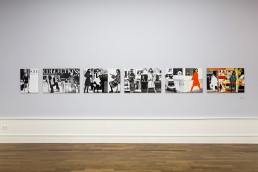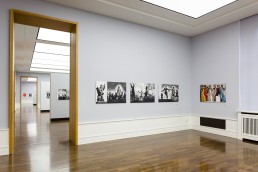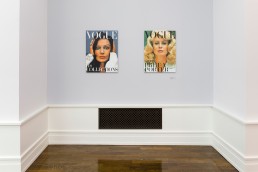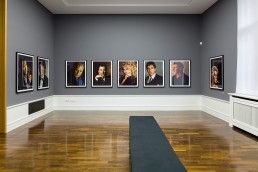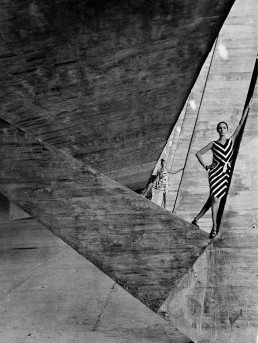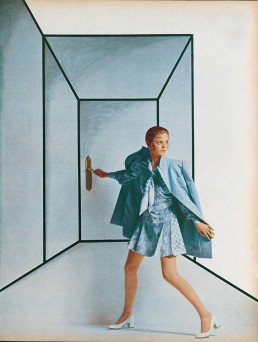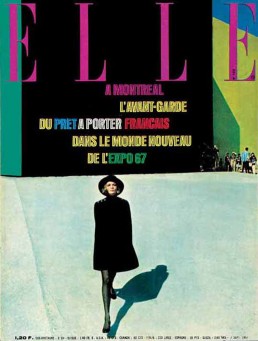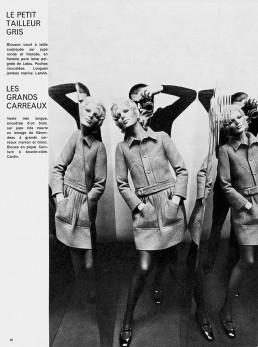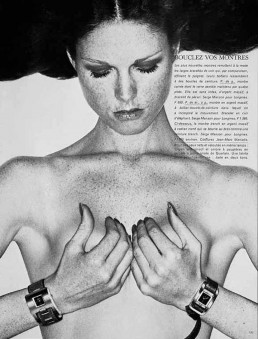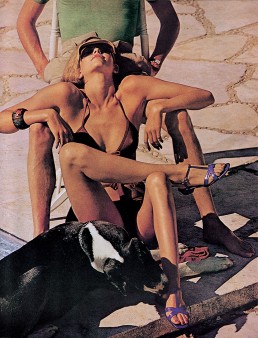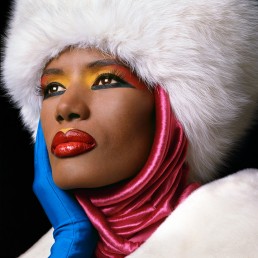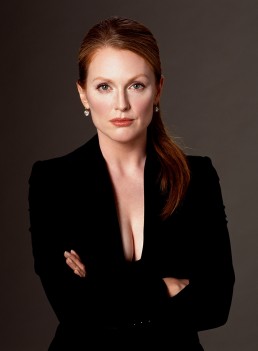The exhibition Pages from the Glossies offers us a new perspective on many of Helmut Newton’s iconic photographs. Spanning more than four decades, the images are presented as facsimiles of the original magazine pages in which they were first published, between 1956 and 1998.
During this considerable length of time, Newton was regularly commissioned by publishers and editors from renowned magazines around the world to impart his version and vision of contemporary fashion. This continuity remained an exception in the otherwise fleeting fashion business.
Photographs that would later become celebrated and coveted were first published in the context of fashion editorials for the likes of Vogue, Elle, Queen, and Stern. In 1998, Newton compiled a selection of these magazine publications in his book, Pages from the Glossies.
The Helmut Newton Foundation is presenting the first-ever exhibition of these single- and double-paged images featured in this book, exhibited as enlarged facsimiles, including their individual layout, commentary, and captions. This presentation remains true to its source, showcasing more than 230 magazine pages and nearly 500 individual pictures. In many of the facsimiles we can discover motifs that Newton would later use in his exhibitions and photo books. We also encounter images that have never before been exhibited. As published photographs approved by Helmut Newton, they too are considered a legitimate part of his oeuvre.
This comprehensive exhibition of Newton’s work will again be accompanied by the work of another photographer. Greg Gorman shows in June’s Room his Color Works, color portraits of prominent musicians, visual artists, and actors, mostly hailing from the United States, including David Bowie, Grace Jones, Andy Warhol, and Julianne Moore.
Selected Works
Pages from the Glossies
Matthias Harder
The exhibition Pages from the Glossies offers us a new perspective on many of Helmut Newton’s iconic photographs. Spanning more than four decades, the images are presented as facsimiles of the original magazine pages in which they were first published, between 1956 and 1998. During this considerable length of time and beyond, Newton was regularly commissioned by publishers and editors from renowned magazines around the world to impart his version and vision of contemporary fashion. This continuity remained an exception in the otherwise fleeting fashion business.
Photographs that would later become celebrated and coveted were first published in the context of fashion editorials for the likes of Vogue, Elle, Queen, and Stern. In the 1960s and 1970s, when many of these iconic images were created and published, decisions on their use rested solely with the magazine editors. Even famous photographers like Helmut Newton had to yield to in-house design decisions concerning the single and double pages, or the final scope of the editorials. Many of his photographs were cropped, and some even overlaid with text; most of them, however, remained untouched.
In 1998, Newton compiled a selection of these high-gloss magazine images in his book, Pages from the Glossies, published by Scalo in Zurich. Long out of print, the book is now reissued by TASCHEN. The Helmut Newton Foundation is presenting the first-ever exhibition of these single- and double-paged images featured in this book, exhibited as enlarged facsimiles, including their individual layout, commentary, and captions. This presentation remains true to its source, showcasing more than 230 magazine pages and nearly 500 individual pictures.
In many of the facsimiles we can discover motifs that Newton would later use in his exhibitions and photo books. We also encounter color and black & white images that have never before been exhibited. As published photographs approved by Helmut Newton, they too are considered a legitimate part of his oeuvre.
Occasionally, for example with the now famous diptych They’re Coming (1981), which was first published in French Vogue, even the black outline of the negative was printed. For insiders, this is an indication of the film stock he used – in this case it was a 6×6 cm roll film – and the full negative format for later enlargements. We can also see how Newton originally composed his image during the shoot at the Parisian Vogue studio in camera – which is how the photographer worked in most cases. Newton’s juxtaposition of nude and clothed models, which would lead to his legendary Naked and Dressed series, first appeared in French Vogue in November 1981. A month earlier Vogue Italia had published comparable outdoor shots taken in Brescia. This show of nude and fashion shots side by side in a fashion magazine triggered a wave of indignation. Today, the diptych They’re Coming, which caused a scandal when first published in France, is a photographic icon that has been reprinted thousands of times. As a life-sized, limited vintage print it has been sold at auction for record prices.
Helmut Newton – with his depiction of women in ways that were sometimes radical yet always elegant – was often a step ahead of the zeitgeist, and influenced it over the decades. In the exhibition’s chronologically arranged facsimiles of Newton’s fashion photographs, visitors will recognize not only the evolution of the photographer’s visual language, but also the shifting role of women in western society since the 1950s. It also becomes apparent how Newton’s autonomous visual language stood out from the magazines’ conventional fashion illustrations.
Magazines were nonetheless a central means of distribution for Newton. Through them, he reached an audience of millions with his fashion images, long before he found other publication and distribution channels for his visual messages through photo books and exhibitions. The Helmut Newton Foundation’s posthumously produced exhibition of Pages from the Glossies, which previously only existed as a book, traces this development. Magazines and books containing Newton’s work are on display in vitrines, showing the images in their original size and the context. We become aware of the extent that Newton pushed the boundaries of his medium over the years and decades of his career, how much he experimented, and how successful he was in challenging social conventions.
This comprehensive exhibition of Newton’s work will again be accompanied by the work of another photographer, honoring Newton’s wish for this curatorial approach upon establishing his foundation. American photographer Greg Gorman returns as a guest following his first exhibition at the Helmut Newton Foundation in 2013. His black-and-white male nudes in June’s Room complemented Helmut Newton’s Big Nudes in the main exhibition space at the time. For this exhibition, June’s Room will now feature 25 color portraits made by Gorman of prominent musicians, visual artists, and actors, mostly hailing from the United States, including David Bowie, Grace Jones, Andy Warhol, and Julianne Moore.
The exhibition Color Works presents Gorman’s color photography for the first time in Germany. Here, we encounter representatives of a global music, art, and film business. In some of his portraits we see how Gorman both reflects and critiques the gradually fading myth of Hollywood. The images, many of which were produced on commission for magazines, are individual and formally diverse. Gorman’s unique photographic style fuses with his clients’ wishes and the impulses of his portrayed subjects in a remarkable mélange.
